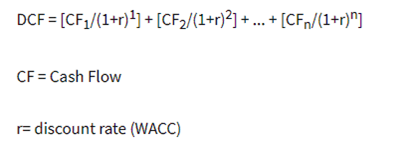Reading: Discounted Cash Flow Model
DCF
Model
•Discounted
cash flow (DCF) is a valuation method used to estimate the attractiveness of an
investment opportunity. DCF analyses use future free cash flow projections and
discounts them, using a required annual rate, to arrive at present value
estimates. A present value estimate is then used to evaluate the potential for
investment. If the value arrived at through DCF analysis is higher than the
current cost of the investment, the opportunity may be a good one.
•The
time value of money is the assumption that a dollar today is worth more than a
dollar tomorrow. For example, assuming 5% annual interest, $1.00 in a savings
account will be worth $1.05 in a year. Due to the symmetric property (if a=b,
then b=a), we must consider $1.05 a year from now to be worth $1.00 today. When
it comes to assessing the future value of investments, it is common to use the
weighted average cost of capital (WACC) as the discount rate.
DCF
Model
•The
firm’s free cash flow can be used to calculate the value of the firm in a
Discounted Cash Flow model.
•Approach
- Forecast the firm’s future free cash flows
- Discount the cash flows using the firm’s WACC
- Equity value = firm assets minus debt value
- Forecast the firm’s future free cash flows
- Discount the cash flows using the firm’s WACC
- Equity value = firm assets minus debt value
DCF
Model
1.Forecast the near-term cash flows
2.Forecast the long-term growth rate and
terminal value
3.Discount the annual cash flows and
terminal value to determine the present value of the firm

Inputs
to the DCF Model
•Forecast
of future cash flows
- Determine base or initial cash flow
- Forecast near and long term growth rates
- Determine base or initial cash flow
- Forecast near and long term growth rates
•Discount
rate: WACC
DCF
Example

DCF
Example
•For a
hypothetical Company X, we would apply DCF analysis by first estimating the
firm's future cash flow growth. We would start by determining the company's
trailing twelve month (TTM) free cash flow (FCF), equal to that period's
operating cash flow minus capital expenditures.
•Say
that Company X's current FCF is $50m. We would compare this figure to previous
years' cash flows in order to estimate a rate of growth. It is also important
to consider the source of this growth. Are sales increasing? Are costs
declining? These factors will inform assessments of the growth rate's
sustainability.
DCF
Example
•Say
that you estimate that Company X's cash flow will grow by 10% in the first two
years, then 5% in the following three. After a few years, you may apply a
long-term cash flow growth rate, representing an assumption of annual growth
from that point on. This value should probably not exceed the long-term growth
prospects of the overall economy by too much; we will say that Company X's is
3%. You will then calculate a WACC; say it comes out to 8%.
•The
terminal value, or long-term valuation the company's growth approaches, is
calculated using the Gordon Growth Model: Terminal value = projected cash flow
for final year (1 + long-term growth rate) / (discount rate - long-term growth
rate).
DCF
Example
•Now
you can estimate the cash flow for each period, including the terminal value:

•Finally,
to calculate Company X's discounted cash flow, you add each of these projected
cash flows, adjusting them for present value, using the WACC:
•
•DCF
of Company X = (55 / 1.081) + (60.5 / 1.082) + (63.53 / 1.083) + (66.70 /
1.084) + (70.04 / 1.085) + (1,442.75 / 1.085) = 1231.83
•
•$1.23
billion is our estimate of Company X's present enterprise value. If the company
has net debt, this needs to be subtracted, as equity holders' claims to a
company's assets are subordinate to bondholders'. The result is an estimate of
the company's fair equity value. If we divide that by the number of shares
outstanding—say, 10 million—we have a fair equity value per share of $123.18,
which we can compare with the market price of the stock. If our estimate is
higher than the current stock price, we might consider Company X a good
investment.
Last modified: Tuesday, August 14, 2018, 8:50 AM
